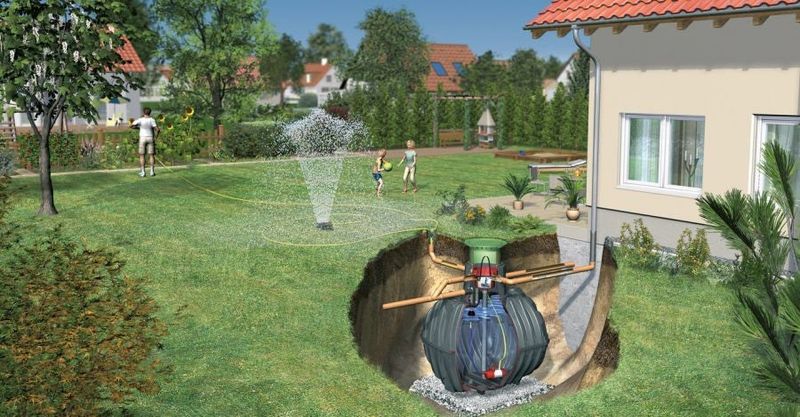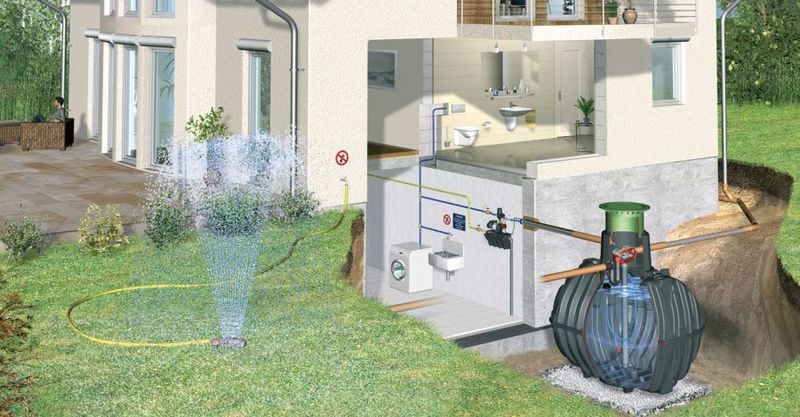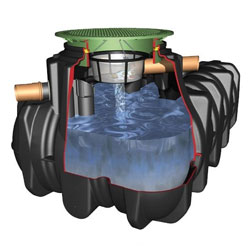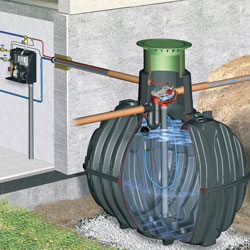A rainwater harvesting tank is a great way to make use of what is essentially a free resource that usually goes to waste – rainwater.
So, it should come as no surprise that rainwater harvesting in the UK has skyrocketed in popularity in recent years.
But with so many water tank sizes available on the market, you’re often left utterly confused, helplessly wondering:
What size rainwater tank do I need?
At Drainage Superstore, we’re often asked that very same question. That’s why we decided to put together a comprehensive guide to help you choose just the right rainwater harvest tank for your needs – neither too large nor too small.
To this end, we’ll go over the relevant factors you need to consider and then show you how to crunch the numbers quickly and accurately all by yourself without having to use a rainwater harvesting calculator.
Read on.
Table of contents:
- Local rainfall & weather patterns
- Your roof size
- Your rainwater usage and property size
- How do I calculate what size water tank I need?
- Final thoughts
Local rainfall & weather patterns

Yes, we all know that it rains a lot in the UK. But we also know that it rains more in some places than it does in others.
So, the first thing you need to do is ask yourself how much it rains where you live. Otherwise, there’s no reliable way to determine how much rainwater you could potentially gather over the course of a year.
Now:
There are different ways to obtain annual rainfall data.
We got the following information for a few UK cities for the 30-year period from 1991 to 2020 from the Met Office to give you a general idea.
| Location | Annual Rainfall (mm) | Rainy Days per Year |
|---|---|---|
| Cardiff | 1203.28 | 153.39 |
| Plymouth | 1037.68 | 148.64 |
| Belfast | 938.70 | 156.18 |
| Inverness | 755.02 | 147.90 |
| Edinburgh | 727.70 | 128.25 |
| London | 722.07 | 119.60 |
As you can see, there are considerable differences across the UK. So, it’s vital that you get as accurate and reliable a figure for your local area as possible.
Ideally, you want the annual averages from the last three or four years rather than the last three decades. Since weather patterns have changed profoundly, it’s possible that older data from, say, the early 1990s, might skew the overall average.
Your roof size

The next thing you need to consider is the size of your rainfall collection area – namely, your roof. To put it simply, the larger your roof, the more rainwater you’ll be able to collect.
To begin with:
We wouldn’t recommend installing a water collection tank if you have a flat roof or even a low-pitched roof with plants, as you’re likely to get only meagre returns on your investment.
So, assuming you have a rectangular house with a standard pitched roof, here’s how you should go about calculating your roof size:
Measure the length of your roof and multiply it by the roof slope height. Keep in mind that this is not the same as the height of your roof. There’s no need to worry, though, as the roof slope height should be noted in the property documents. If it’s not, contact your local authority to obtain it.
Once you have both measurements, you’re left with the following simple equation:
Roof width (m) x roof slope height (m) = half roof area (m²) x 2 = entire roof area (m²)
But how do you calculate how much rainwater can be collected from a roof, I hear you say.
To get a rough estimate, you can use an easy formula:
Roof area (m²) x annual rainfall (mm) = harvested rainwater per year (l)
Why is this a rough estimate?
In an ideal world, the entire annual rainfall would easily find its way into our rainwater storage tanks.
In the real world, however, some rainwater is blown away by high winds, and some roof materials absorb a certain amount of water. Roof pitch also plays a part. That’s why we need to introduce another variable, known as drainage or runoff coefficient.
Now:

The University of Warwick’s School of Engineering suggests that the drainage coefficient usually varies between 0.5 and 0.9, depending on the slope and roof material.
If you’re able to estimate your specific drainage coefficient, you can use that figure. If not – which is perfectly fine – you can use 0.8 as a safe bet.
This leaves you with the following updated formula:
Roof area (m²) x annual rainfall (mm) x drainage coefficient = harvested rainwater per year (l)
Now that we’ve established how much rainwater you could potentially harvest each year, it’s time to see what your current and potential needs and usage are.
And that’s exactly what we’re going to look at next.
Your rainwater usage and property size
At this point, you might be tempted to simply go ahead and purchase the biggest UK rainwater harvesting system available that will accommodate the total amount of water you can harvest.
Think again.
A large rainwater tank might not be your best bet because:
- You don’t use nearly as much water
- It takes up too much space
- It’s too expensive
So, rather than splurging out now and regretting it later, try to get a rough estimate of your current and, ideally, future needs.

Check this out:
If you only intend to use your rainwater collection tank’s harvest for domestic purposes, such as flushing the toilet and running a washing machine, you’ll need to establish each household member’s water consumption per day. Naturally, this can be quite tricky, since we all have different needs, not to mention the vastly varying efficiency of different models of toilets and washers, among other appliances.
Once you’ve come up with a rough average, however, you’re left with a very simple equation:
Total annual consumption = personal daily consumption x number of occupants x 365
So, if your two-member household lives in a four-bed house, you should only consider rainwater tank sizes suitable for two people, right?
Not quite.
It’s much better to invest in a tank large enough to accommodate the total potential usage of the property – in this case, four people. This way, if your household happens to grow or you decide to sell the property and move on, you won’t find yourself at a sudden financial loss.
The next question is:
How much rainwater storage do I need for my garden?

Many of us in the UK love our gardens and tend to think of a rainwater harvesting tank first and foremost as a garden water tank. If that includes you, you’ll have to factor in your garden irrigation.
As with your home, the total amount of garden water storage you’re going to need will largely depend on the size of your garden. The other key factor here is the average number of consecutive dry days you’re likely to expect.
Now:
From here on, you can use a typical watering can (approximately 5 litres) as your unit of measurement. If your average daily usage is 4 cans, and you can expect up to 12 dry days, you’re looking at a 240+ litre water butt.
Once again, you don’t want to go too big.
People often ask:
How long can you store rainwater for plants?
While you don’t want rainwater to become stale from being in your tank too long, modern water harvest tanks can easily preserve it free from contamination for several weeks at a time.
Hopefully, you won’t have to deal with such an extended drought, though!
How do I calculate what size water tank I need?
Now that you know your approximate domestic and/or gardening rainwater needs, it’s simply a matter of adding the two and deciding whether to go for the current or potential demand. Don’t forget to add another 10% or so to the final figure to cover any emergencies, and you should be good to go!
In general, here are the water tank sizes you’re likely to end up considering:
- 1-to-4-member household with little to no garden watering – 1500-3000-litre tank
- 4-to-6-member household with some garden watering – 5000-litre tank
- 4-to-6-member household with regular garden watering – 7500-litre tank
Naturally, these are all averages, but the general pattern still holds true.
Final thoughts

Rainwater collection in the UK is on the rise, as more and more homeowners are embracing a sustainable, eco-friendly lifestyle while simultaneously looking to raise the value of their property.
As we’ve seen, choosing the right size rainwater harvesting tank can be a bit tricky due to the multiple factors involved in the equations.
But now that you know exactly how you need to go about the various calculations, you can be confident you’ll make the perfect choice.
What’s more:
Your friends and neighbours will no doubt be highly impressed with your expertise and flock to you, asking:
What size rainwater tank do I need?
And yes, you’ll be able to help them out.















